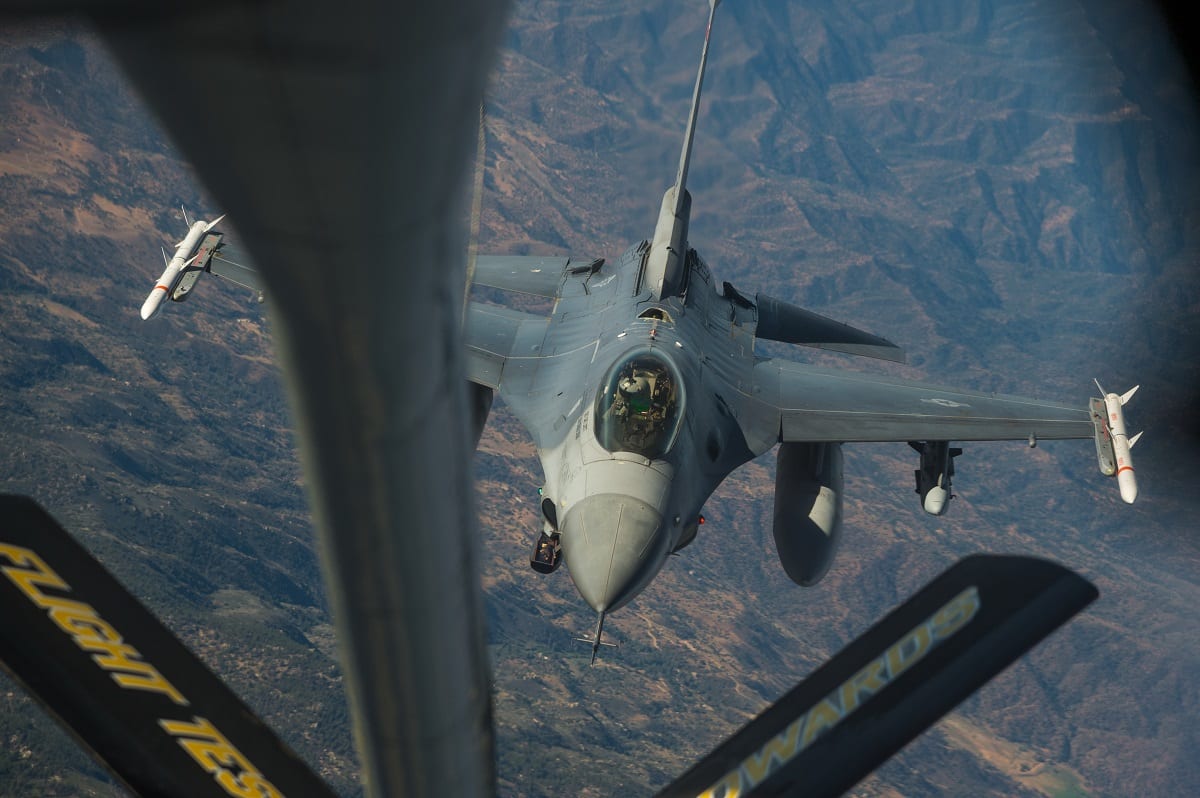
An F-16 Fighting Falcon flown by U.S. Air Force Maj. Jacob Schonig from the 416th Flight Test Squadron at Edwards AFB, Calif., conducts a mid-air refueling operation with a KC-135 Stratotanker during a captive-carry flight test of a Gray Wolf cruise missile prototype on June 9, 2020 (U.S. Air Force)
Last fall, former U.S. Air Force acquisitions chief Will Roper held out the possibility that the service would soon announce an e-series, digitally engineered weapon to follow the Air Force designation of the eT-7A training aircraft as the service’s first e-series platform and aircraft.
While the Air Force has yet to disclose what its first digitally engineered munition will be and when the latter could field, development efforts are ongoing within the Air Force at Program Executive Officer for Weapons and Air Force Research Laboratory (AFRL) and at contractors, such as Lockheed Martin‘s Skunk Works division, which is using internal research and development funding and the company’s StarDrive digital engineering process to develop the Speed Racer cruise missile drone.
At AFRL’s munitions directorate at Eglin AFB, Fla., digital twins of the Gray Wolf low-cost cruise missile prototype have shown promise, Air Force Col. Garry Haase, the commander of AFRL’s munitions directorate, said on March 26 during an AFCEA International forum.
AFRL’s WeaponONE pathfinder program has used artificial intelligence/machine learning (AI/ML)-aided digital twins in an effort to improve the performance of Gray Wolf.
“We ran a scenario where we were going against the threat with this digital twin,” Haase said on March 26. “It encountered some challenges so it was not able to prosecute the target. Because it was networked in, fed back the information it was gathering as it was going in, we were able to apply that information to a large number of machine learning-type of runs to evaluate how we can do it better. We came up with a different set of plays. We updated the software [to see] if there’s a different playbook we can go off of with these systems. It was a swarming model where we had a group of these systems that were collaborating and some autonomy.”
“We discovered what we think is a more capable playbook,” he said, adding that AFRL uploaded new software in order to improve the performance of the Gray Wolf digital twins within a simulated 24-hour air tasking order (ATO) cycle. “One day it [the software] didn’t work. We wanted to be able to make it work…We showed we could do that within the digital environment.”
During a Dec. 15 flight last year, a Lockheed Martin U-2 reconnaissance aircraft used the ARTUµ artificial intelligence (AI) algorithm by Booz Allen Hamilton to help navigate the plane and steer the plane’s Raytheon Advanced Synthetic Aperture Radar System-2A (ASARS-2A) in the search for simulated enemy missile launchers in what the Air Force said was the first time AI has commanded a military system.
Haase said that lessons learned from in-flight updates of U-2 missions systems could apply to Gray Wolf.
“We think we could do it even faster on a second wave [of Gray Wolf attacks] on the first [conflict] day,” Haase said “We could potentially, if we have enough bandwidth in the pipes, pass updated playbooks to systems as a next wave.”
More than two years ago, AFRL’s Gray Wolf program consisted of four spiral-development phases to develop and field a $100,000 cruise missile that could act in swarms to defeat enemy air defenses. Plans called for multiple options from decoy to electronic attack to long range high-explosive warheads against peer adversaries.
Lockheed Martin and Northrop Grumman held five-year, $110 million contracts to develop the missile, to be tested first on F-16 fighters and compatible with F-35, F-15, F-18, B-1, B-2 and B-52 aircraft. But the Air Force decided two years ago to shift funds away from the Lockheed Martin proposal to kick start Golden Horde.
Due to lack of a funding for spirals two through four, AFRL narrowed the scope of Gray Wolf to Northrop Grumman’s involvement in spiral one.
This article was first published by Defense Daily, it has been edited. Click here to view the original version.